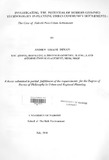| dc.description.abstract | For many years, planners and urban development managers in Third World countries have endeavored to respond to the challenges posed by the phenomenal urbanization trends, but with limited success. The main limitations to planning and management efforts are attributable to the inadequacies of the existing national land use policies, institutional and technical frameworks, mapping and planning systems and approaches. Additionally, the apparent exclusion of the affected community citizens and other stakeholders, of the present day era of democratic information-age society, has further played a major role to ineffectiveness in planning and managing urban settlements of most third world cities, such as Nairobi, Kenya.
In view of the prevailing urbanization trends and challenges therefore, the main purpose of this study is to investigate the potential of modem digital geo-information technologies (GITs) as alternatives for effective development planning and management of rapidly growing urban settlements as opposed to conventionally used cadastral-based geo-systems and planning approaches. The geo-information systems include; Remote Sensing technology (RS), Global Positioning Systems (GPS), Geographic Information Systems (GIS) and the Internet. Further, the study particularly explores the potential of GITs integration with community-based participatory planning and management of rapidly growing urban settlements.
Firstly, the research provides an overview of the theoretical concepts that appertains to the study subject matter (Chapter Two). Secondly a brief analytical review of related literature is given, which initially includes an overview of the current urbanization trends and challenges at global, regional and local perspectives (Chapter Three). Thirdly the mapping, development planning and management needs, problems and requirements in Kenya's urban areas in general, and Nairobi City in particular are examined.
Using a case study of a typical peri-urban settlement of Mlolongo, a satellite of Nairobi, spatial development problems are closely studied (Chapter Four). Fourthly, in an attempt to seek diverse views regarding the research problem and concerns, a questionnaire interview instrument is used in soliciting alternative opinions from a spectrum of stakeholders and actors (Chapter Five).
Chapter Six demonstrates the potential of modem GITs vis-a-vis traditionally used cadastralbased mapping / planning techniques in terms of; cost-effectiveness and efficiency, accuracy acceptability, multi-user applicability, and enhancement of public participation in development planning, management and governance of urban community settlements. Finally, Chapter Seven provides the summary, conclusions and recommendations as drawn from the research results and study findings | en_US |

